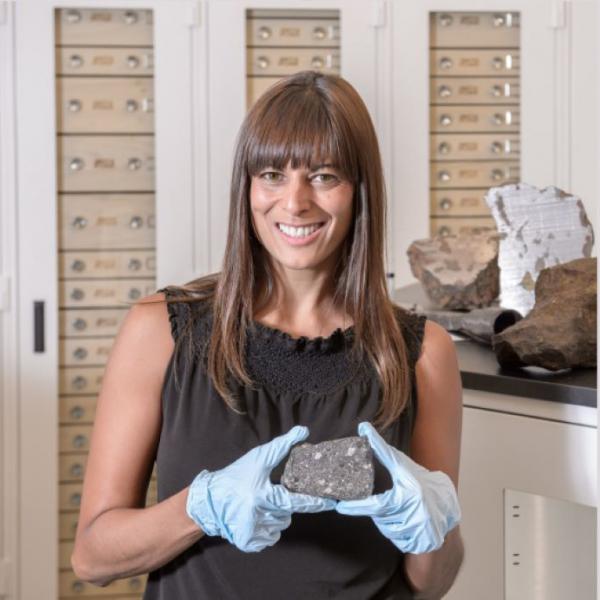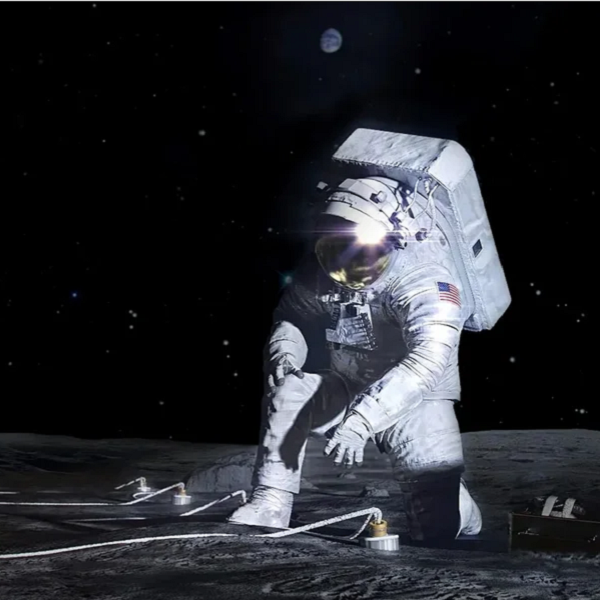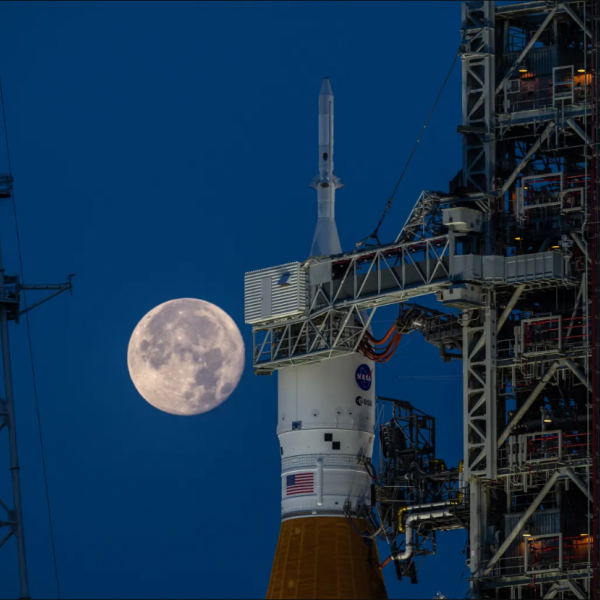For their centennial celebration, AGU's Fall Meeting was back in San Francisco with approximately 25,000 attendees. The Department of Earth and Planetary Sciences was represented at AGU by nearly two dozen members across research areas. Here are some highlights from the week-long event.
Monday, December 9, 2019
Jeff Catalano gave an invited and highlighted lecture on “Comparative Redox Geochemistry of Early Earth and Early Mars: Implications for Habitability.” Catalano’s primary question centered around when oxidizing events occurred on Earth and Mars. We know the Martian atmosphere is oxidizing now (because we can see the rust), but what about early Mars? The oxidation timeline has implications for habitability and the evolution of life on Mars as well as on Earth. Read more about the work presented in this talk in Eos.
Michael Wysession introduced a new journal from AGU, Perspectives of Earth and Space Scientists, which celebrates AGU’s centennial by sharing stories from AGU fellows and other authors. The journal seeks to celebrate and document AGU’s rich history and inspire future scientists.
Our annual alumni mixer with Northwestern University was a great way to start off the week-long conference. Check out our Instagram (@WUSTLEPS) for photos of alumni and friends in attendance.
Tuesday, December 10, 2019
Bronwen Konecky was invited to present her work on “Evaluation of triple oxygen isotopes in daily East African precipitation as a potential tracer of recycled continental moisture.” She specifically considered the impacts of continental processes on hydroclimate. By analyzing oxygen isotopes in rainfall across several sites in East Africa, Konecky was able to determine the history of rain events at these sites and whether precipitation comes from recycled continental sources or oceanic sources.
Nadia Sae-Lim delivered a talk on “Investigation of climate, terrestrial ecosystems, and aquatic productivity during the past ~1500 years from the Lake Sibinacocha watershed, Peruvian Andes.” Sae-Lim conducted moisture and temperature studies in the high Peruvian Andes at Lake Sibinacocha. Her results show progressive, pre-industrial cooling, followed by warming after 1980 and suggest that areas at high altitudes may be warming faster than their lowland counterparts.
Mike Krawczynski and co-author Timothy Grove from MIT shared a poster on “The super-hydrous component of the Mt. Shasta plumbing system.” Their work focuses on evidence of super-hydrous magmas (those containing greater than 8 wt% water) at Mt. Shasta, the largest Cascade stratovolcano. This research is related to Krawczynski’s ongoing work on wetter-than-expected magma.
Two town hall events with co-organizers from our faculty took place on Tuesday:
The Experimental Deformation Data System town hall focused on incorporating experimental rock deformation data into digital data systems and included Phil Skemer as a co-organizer. The experimental deformation data system is designed to provide a shared database, including metadata, to increase the availability and usability of the results of rock deformation experiments. Currently, additional community input is being sought to set standards and improve usability of the platform.
Bronwen Konecky was a co-presenter at a town hall on “Water Isotope Applications in Atmosphere, Ocean, and Climate Science: Progress and Goals of the U.S. CLIVAR Water Isotope Working Group.” This town hall emphasized the need for shared data, models, and platforms to support wide ranging advances in our understanding of the global hydroclimate cycle and how it will respond to climate change.
Wednesday, December 11, 2019
Doug Wiens gave an invited talk titled “The Water Cycle in Subduction Zones as Constrained by Seismology.” Based on seismic imaging and earthquake studies near the Mariana Trench, Wiens concluded that more water (approximately 3 times more than previous estimates) is being carried down in the subducting mantle globally. This larger influx of water also implies that more water must be coming out, for example at volcanic arcs. Read more in Nature.
Claire Masteller, who will be joining us at WashU in January, organized a panel and poster session on “The Role and Relevance of Thresholds and Variability Across Landscapes.” These sessions focused on how the changing form of a landscape reflects the interaction of geomorphic processes and environmental conditions.
Xiaochen Mao presented a poster on “Spindown of 2014 MU69 (“Ultima Thule”) by impact of small, cold classical Kuiper belt objects.” Mao examined one pathway by which the bilobate Arrokoth (formerly known as Ultima Thule) might have formed from the gravitational collapse and eventual merger of a telescopic binary system, common in the Kuiper belt.
Wednesday evening’s event was the most formal of the week. The 2019 AGU Honor’s Tribute recognized awardees, medalists, prize recipients, and new AGU Fellows. Michael Wysession received the Spilhaus Ambassador Award Grant in support of his work with Washington University’s Institute for School Partnership (ISP). With ISP, a nonprofit science program, Wysession will help bring a modern, high-quality science curriculum to St. Louis regional elementary and middle schools. The curriculum is designed around Next Generation Science Standards, open source, and available at cost to schools.
Bronwen Konecky was also recognized by the Paleoceanography and Paleoclimatology section as the winner of this year’s Nanne Weber Early Career Award.
Thursday, December 12, 2019
Georgy Falster presented “New insights into spatial and temporal dynamics of the global water cycle from the Iso2k database.” By gathering different types of records—such as ice cores and lake sediments—with different markers for temperature, moisture, and isotopes, the Iso2k database can capture larger patterns than individual researchers can alone. Falster noted that global patterns were often only visible when looking at many archives, while they were less apparent in individual sites.
Rita Parai gave an invited talk titled “Superimposed Signatures of Ancient Heterogeneity and Long-term Volatile Transport from Noble Gases.” Tracking noble gas isotopes across timescales, Parai shows differences in degassing and regassing histories as well as ancient composition.
Bill McKinnon presented his work “On the solar nebula origin of (486958) 2014 MU69, a primordial contact binary in the Kuiper belt.” In his talk, McKinnon described the likely process for the formation of Arrokoth (formerly known as Ultima Thule). Arrokoth probably began as a co-orbiting binary with both bodies aligned before merger and slowly had its angular momentum drained, likely by gas drag.
Zhengyang Zhou gave a talk titled “The azimuthal seismic anisotropy of Antarctica from ambient noise Rayleigh waves,” in which he described his newly derived depth-dependent model for Antarctic anisotropy. The model makes use of all currently available data and improves measurements using advanced computational methods.
Thursday was a busy day for posters, including three from Doug Wiens’ group:
Maeva Pourpoint, “Constraints on the lithospheric structure of southern Patagonia from receiver function and surface wave analysis”
Zongshan Li, “Crust and uppermost mantle structure of the Alaska subduction zone from ambient noise tomography”
Andrew Lloyd, “Decoding Cenozoic tectonics in Patagonia, the Scotia Sea, and the Antarctic Peninsula from new seismic tomography”
Ghassan Aleqabi also presented a poster on “Deep learning using a convolutional neural network for the classification of seismic Green’s functions.” Aleqabi makes use of machine learning techniques to detect patterns in waveforms and use that information to indicate seismic source type. His initial results show a remarkable 96% accuracy in classifying waveforms.
Friday, December 13, 2019
Mattison Barickman gave a poster on “Boron isotopic constraints on slab and mantle-derived fluid and melt sources of Nicaraguan volcanics.” Barickman’s work is notable not only for its insights into regional and volcano-specific processes, but also for how many departmental collaborators it boasts across fields. In addition to Barickman’s advisor, Rita Parai, this research draws on the expertise of David Fike, Mike Krawczynski, and Kun Wang.
Did we miss you? Contact Shawn Ballard with any additions or corrections.




